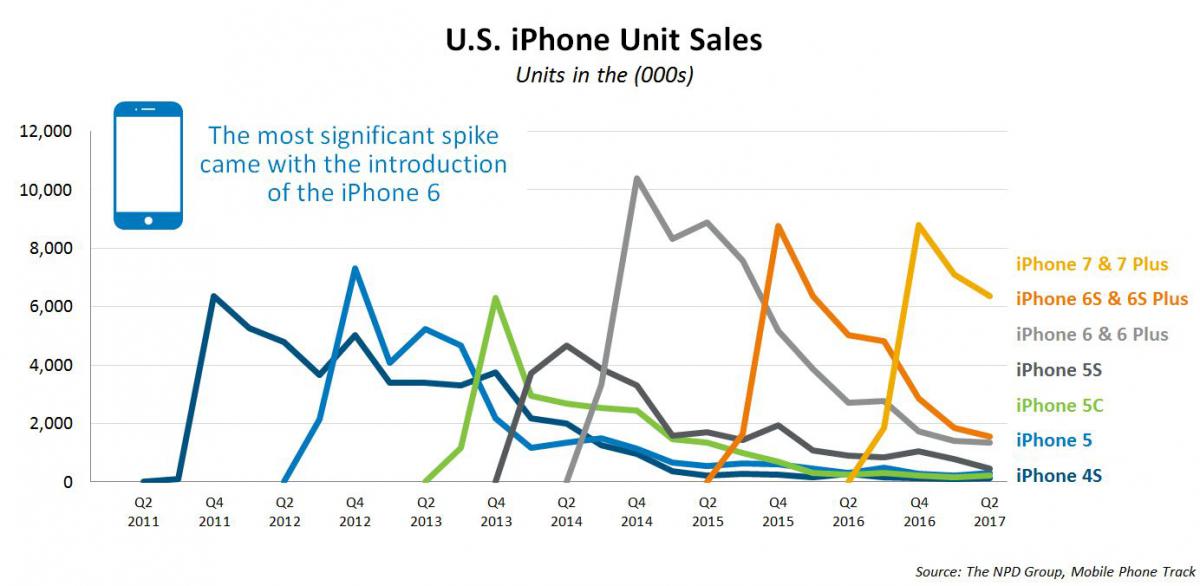Tomorrow, Apple is expected to launch its next generation iPhone. Assuming the anticipated announcement becomes a reality, this will mark 10 years since Apple entered the smartphone market and fundamentally changed not only what we expect from a phone, but also the competitive landscape for mobile phones – and smartphones in particular. Theoretically, this next iPhone should be an incremental enhancement, following Apple’s pattern of launching the “S” version every other year; but, Apple cannot (and will not) simply launch a minor hardware update for the 10th anniversary. Apple is working to stay at the leading edge of the market as competition looks to build faster and more aesthetically pleasing alternatives to the iPhone behemoth.
While there’s interest in the underlying specs of any new phone, the reality of consumer interest is more skin deep. For most consumers, a sexy looking phone and a good camera are the obvious hardware features used to pique interest (we’ll get into software below). The chart below helps to demonstrate this fact.
By leveraging estimated sales data from NPD’s Mobile Phone Track, we can see significant spikes in sales with the launch of each iPhone model. The most significant spike came with the introduction of the iPhone 6 (in Q2 2014), which saw a change in shape and size for the iPhone. In other words, this model made it obvious, even at a quick glance, which consumers had the latest and greatest device when they pulled out their phone to check an email or answer a call. Taking an iPhone 6 out of your pocket in public had almost, but not quite, the same effect as when the initial iPhone launched, when people either had an iPhone... or they didn’t. There’s a “wow” factor.

We believe we can expect the same type of spike that the iPhone 6 saw – perhaps even greater – if Apple does launch a significant tenth anniversary iPhone X device. This type of device is one that consumers will want, or feel they need, to be seen with if they are an iPhone user. This brings us to another key factor in Apple’s success in the mobile phone market: its customer loyalty and retention rate is far greater than other devices. According to the latest Connected Mobility Report from NPD’s Connected Intelligence, just over 90 percent of Apple iPhone customers purchase another iPhone when they decide to upgrade devices.
What is also interesting, looking at the above chart, is that the launch of a new device has not caused a significant spike in older models at the same time. A logical theory would say that when a new phone launches, promotional activity on the older model will cause an uptick in sales. But that has rarely been the case; due mainly to the payment plans offered by carriers, which has meant that the monthly fee for a new phone is not that significantly different from older models.
Another reason to believe that the next iPhone launch will cause a larger than usual spike is that according to NPD’s Connected Intelligence, iPhone users typically hold onto their phone for 18-30 months, suggesting that they skip at least one generation of a new device launch. With over half of iPhone users reporting that they hold onto their device for 24+ months, we can expect that consumers who bought an iPhone 6 may be stretching the device’s life a little further than usual in order to wait for the new generation device to launch. Indeed, since the iPhone 7 was, in many ways, more of an incremental update rather than a fundamental change, we can expect that consumers will have been prepared to wait a little longer for the new update, which helps to explain why the iPhone 6 sales spike was higher than the subsequent two device launches. After all, the theory of an iconic 10 year anniversary device has been well talked about for the past year.
But it would be wrong to focus simply on the skin-deep appeal of the device’s body alone. Another key driver for the iPhone has always been the software and ease of use. FaceTime, for example, has proved to be a great retention tool. Once you embrace video chat with FaceTime, it’s very hard to give up. And with this next device, there are high expectations for augmented reality features that could again change the scope of how we use an iPhone. Apple is hardly alone in chasing this dream, but the company has the largest installed base to ensure that adoption of AR and other features occurs rapidly and is widespread, thus tempting new and current iPhone customers to want, or again need, the new device in order to stay current.
And finally, let’s not forget the carriers in all of this. iPhone customers are key to their ongoing success, and we can expect all four of the major carriers to be promoting major deals – in terms of payment plans and device exchanges – in order to keep their existing bases, as well as attempting to pull prospective customers from the competing carriers. In other words, get ready for a mass of promotional activity as the carriers work to stake their claims this week. Of course, there’s a rather large caveat to this: there are rumors that the iPhone X may only be available in limited numbers to start. This will require a fine balancing act by the carriers, who are, on the one hand, keen to grab as many customers as they can, but on the other hand, wary of over-promising availability on a device that may lead to large back-orders and disgruntled customers.
The combination of an iconic phone launch, along with the carriers’ appetite for greater growth in a saturated market, means that this week’s anticipated iPhone launch could be one of the most significant mobile phone launches since the first iPhone shook the status quo. And with Apple, the “X” factor is almost guaranteed.